| کد مقاله | کد نشریه | سال انتشار | مقاله انگلیسی | نسخه تمام متن |
|---|---|---|---|---|
| 4034941 | 1263494 | 2008 | 7 صفحه PDF | دانلود رایگان |

Crowding of oriented signals has been explained as linear, compulsory averaging of the signals from target and flankers [Parkes, L., Lund, J., Angelucci, A., Solomon, J. A., & Morgan, M. (2001). Compulsory averaging of crowded orientation signals in human vision. Nature Neuroscience, 4(7), 739–744]. On the other hand, a comparable search task with sparse stimuli is well modeled by a ‘Signed–Max’ rule that integrates non-linearly local tilt estimates [Baldassi, S., & Verghese, P. (2002). Comparing integration rules in visual search. Journal of Vision, 2(8), 559–570], as reflected by the bimodality of the distributions of reported tilts in a magnitude matching task [Baldassi, S., Megna, N., & Burr, D. C. (2006). Visual clutter causes high-magnitude errors. PLoS Biology, 4(3), e56]. This study compares the two models in the context of crowding by using a magnitude matching task, to measure distributions of perceived target angles and a localization task, to probe the degree of access to local information. Response distributions were bimodal, implying uncertainty, only in the presence of abutting flankers. Localization of the target is relatively preserved but it quantitatively falls in between the predictions of the two models, possibly suggesting local averaging followed by a max operation. This challenges the notion of global averaging and suggests some conscious access to local orientation estimates.
Journal: Vision Research - Volume 48, Issue 22, October 2008, Pages 2352–2358